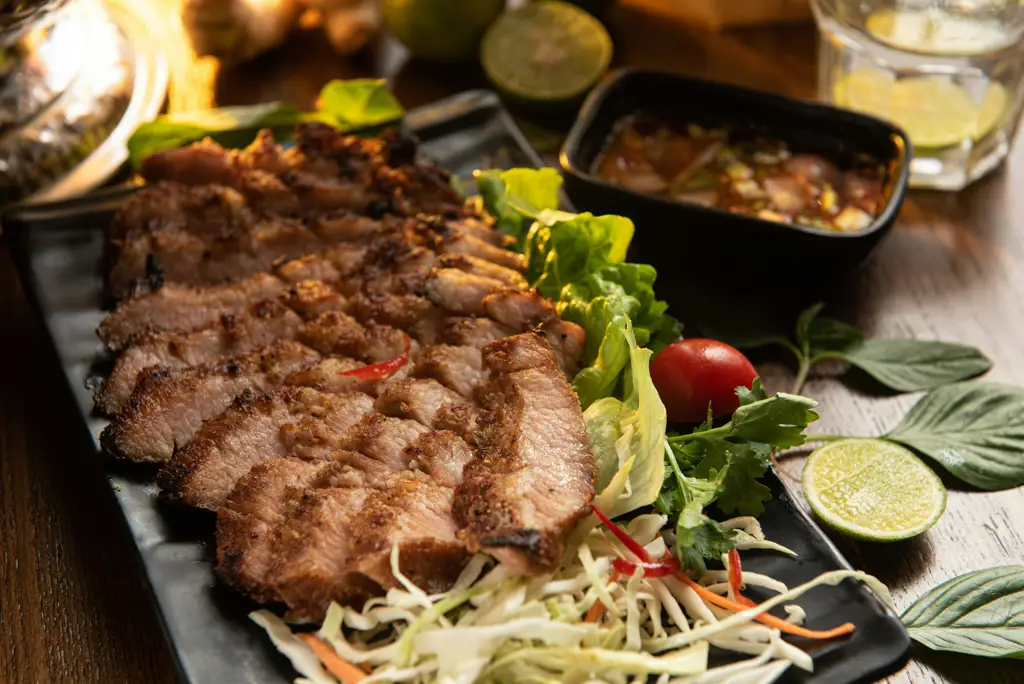Prepare to embark on a culinary journey to Thailand with our recipe for Thai Basil Chicken, a dish bursting with vibrant flavors and rich cultural history. This beloved national favorite isn’t just a meal; it’s a reflection of Thailand’s diverse culinary landscape, a testament to its resourceful use of readily available ingredients, and a showcase of its unique approach to balancing sweet, sour, salty, spicy, and bitter taste profiles. While pinpointing the exact origin is difficult, its popularity exploded in the mid-20th century, coinciding with the rise of street food culture in Thailand. This accessible and affordable dish quickly became a staple, found everywhere from bustling markets to upscale restaurants.
The magic of Thai Basil Chicken lies not only in its deliciousness but also in its simplicity. The dish’s core ingredients are readily available and relatively inexpensive, making it a mainstay in Thai households for generations. The fragrant holy basil (horapa), a key component, is integral to Thai cuisine, representing more than just a culinary herb; it holds symbolic meaning in some Thai traditions. The tender chicken, often stir-fried to perfection, is a versatile protein that complements the other flavors beautifully. Statistics show that chicken is one of the most consumed meats in Thailand, underscoring its importance in the national diet. This widespread availability and affordability contributed immensely to the dish’s widespread popularity.
Beyond its culinary appeal, Thai Basil Chicken holds significant cultural weight. It’s a dish often shared during family gatherings and celebrations, symbolizing togetherness and community. The process of preparing it, from chopping the vegetables to perfectly balancing the sauce, is often a shared activity, bringing families and friends together. Furthermore, its presence in countless street food stalls across the country reflects its role in everyday Thai life. It’s estimated that street food contributes significantly to Thailand’s GDP, and dishes like Thai Basil Chicken are major contributors to this economic success. Therefore, making this dish isn’t merely cooking; it’s engaging with a rich culinary tradition and a vibrant culture.
Ingredients and Measurements
This recipe yields approximately 4 servings of delicious Thai Basil Chicken. Accurate measurements are crucial for achieving the perfect balance of flavors. Using a kitchen scale is highly recommended for precise measurements, especially for the aromatics.
Chicken: 1.5 lbs boneless, skinless chicken thighs, cut into 1-inch pieces. Chicken thighs are preferred for their juiciness and flavor compared to chicken breasts, which can become dry.
Marinade:
- 2 cloves garlic, minced (approximately 1 teaspoon)
- 1 tablespoon fish sauce – Use a high-quality fish sauce for the best results. The quality significantly impacts the overall taste.
- 1 tablespoon soy sauce – Low sodium soy sauce is recommended to control the saltiness.
- 1 tablespoon brown sugar – Dark brown sugar adds a deeper, richer flavor.
- 1 teaspoon cornstarch – This helps to tenderize the chicken and create a slightly thicker sauce.
- 1/2 teaspoon freshly ground black pepper
Stir-fry Sauce:
- 2 tablespoons fish sauce
- 2 tablespoons soy sauce (low sodium)
- 2 tablespoons brown sugar
- 1 tablespoon rice vinegar – Rice vinegar provides a nice acidity that balances the richness of the dish.
- 1/2 cup chicken broth – Use low-sodium chicken broth to control the sodium content.
- 1-2 red Thai chilies, finely sliced (adjust to your spice preference) – Handle chilies carefully to avoid getting the oils on your skin.
Other Ingredients:
- 2 tablespoons vegetable oil
- 1 medium red bell pepper, thinly sliced
- 1 medium onion, thinly sliced
- 1 cup fresh Thai basil leaves – Use only fresh Thai basil, as other basil varieties will not provide the same flavor.
- 1/4 cup chopped peanuts (optional, for garnish)
Important Note: Prepare all ingredients before you begin cooking. This will ensure a smooth and efficient cooking process. Mise en place is key to success in stir-frying.
Preparation of Chicken and Vegetables
Begin by preparing the chicken. We’ll be using about 1.5 lbs (680g) of boneless, skinless chicken thighs, cut into 1-inch pieces. Chicken thighs are preferred for their juiciness and flavor in this recipe. Ensure the chicken is completely thawed before proceeding. Pat the chicken pieces dry with paper towels; this helps them brown nicely when stir-fried.
Next, let’s tackle the vegetables. For this Thai Basil Chicken recipe, we’ll need a vibrant mix. Start with 1 large red bell pepper, cored, seeded, and thinly sliced. The vibrant color adds visual appeal and a touch of sweetness. Then, prepare 1 large onion, peeled and sliced into half-moons. Choose a sweet onion like Vidalia for a milder flavor, or a yellow onion for a more pungent bite. We’ll also need 2 cloves of garlic, minced finely. Mincing the garlic ensures even distribution of flavor throughout the dish.
For added freshness and texture, we’ll incorporate 1 cup of fresh Thai basil leaves. If fresh Thai basil is unavailable, substitute with regular basil, but be mindful that the flavor profile will differ slightly. Before adding the basil to the stir-fry, roughly chop the leaves. Avoid over-chopping, as you want to retain some texture. Finally, prepare 1-2 Thai chilies, finely chopped (adjust quantity based on your spice preference). Handle chilies cautiously, as they can irritate the skin and eyes. Wash your hands thoroughly after handling them.
Proper preparation is key to a successful Thai Basil Chicken dish. Having all your ingredients prepped and measured before you begin cooking will ensure a smooth and efficient cooking process. This will also prevent the chicken and vegetables from overcooking while you’re still prepping other ingredients. Organize your workspace and keep everything within easy reach for a seamless cooking experience.
Once you have all the ingredients prepared, you can proceed to the next step: marinating the chicken (optional, but recommended). A simple marinade can significantly enhance the flavor of the chicken. Consider a marinade of soy sauce, fish sauce, and a touch of sugar for a balanced, savory, and slightly sweet flavor profile.
Marinade for Chicken (if applicable)
A flavorful marinade is crucial for tender and intensely aromatic Thai Basil Chicken. This recipe utilizes a balance of sweet, savory, sour, and spicy elements to create a truly unforgettable taste. We recommend marinating the chicken for at least 30 minutes, but ideally for 2-4 hours in the refrigerator for optimal flavor penetration. Longer marinating times, up to overnight, are also acceptable, provided the chicken remains refrigerated.
Ingredients for the Marinade:
- 1/4 cup fish sauce (adjust to your preference, some prefer less)
- 2 tablespoons soy sauce (low sodium preferred)
- 2 tablespoons brown sugar (or palm sugar for a richer flavor)
- 2 tablespoons rice vinegar (or white wine vinegar)
- 2 cloves garlic, minced
- 1 tablespoon grated fresh ginger
- 1-2 Thai red chilies, finely chopped (adjust to your spice preference; remove seeds for less heat)
- 1 tablespoon vegetable oil
Instructions for making the Marinade:
In a medium-sized bowl, whisk together the fish sauce, soy sauce, brown sugar, rice vinegar, minced garlic, grated ginger, and chopped chilies until the sugar is dissolved. Ensure the sugar is fully dissolved to prevent it from sticking to the chicken during cooking. Then, add the vegetable oil and whisk again to combine. The oil helps to keep the chicken moist and prevents it from drying out during cooking.
Preparing the Chicken for Marinating:
Cut your chicken into bite-sized pieces. Ensure the chicken is cut uniformly to ensure even cooking. Place the chicken pieces into a resealable plastic bag or a shallow dish. Pour the marinade over the chicken, ensuring all pieces are thoroughly coated. Seal the bag tightly or cover the dish with plastic wrap. Refrigerate for at least 30 minutes, or preferably 2-4 hours.
Important Notes:
Don’t overcrowd the container when marinating; ensure the chicken has enough space to be fully coated and allows for even marinade distribution. If you are marinating overnight, ensure you transfer the marinated chicken to a separate container before cooking to prevent bacterial growth. After marinating, remove the chicken from the marinade before cooking. Do not use the leftover marinade to cook the chicken for safety reasons.
Variations:
For a sweeter marinade, add an extra tablespoon of brown sugar. For a more intense garlic flavor, add an extra clove or two. If you prefer a less spicy dish, reduce the amount of chilies or omit them entirely. Experiment with different types of vinegar to find your preferred flavor profile.
Stir-fry Technique
Mastering the stir-fry technique is crucial for achieving that signature Thai Basil Chicken flavor and texture. It’s all about speed, high heat, and proper ingredient order. We’ll be using a wok, but a large, heavy-bottomed skillet will work in a pinch. Ensure your wok or skillet is properly seasoned to prevent sticking.
Begin by heating 2 tablespoons of vegetable oil (or your preferred high-heat oil like canola) in your wok over high heat. The oil should be shimmering but not smoking – this indicates it’s reached the optimal temperature. Once hot, add 1 pound of boneless, skinless chicken breast that’s been cut into bite-sized pieces. Do not overcrowd the wok; work in batches if necessary to ensure even cooking. Stir-fry the chicken for 3-4 minutes, or until it’s browned and almost cooked through. Remove the chicken from the wok and set aside.
Next, add 1/2 cup of chopped vegetables (e.g., bell peppers, onions, and/or zucchini). Stir-fry for 2-3 minutes, until slightly softened. Don’t overcook the vegetables; you want them to retain some crispness. Then, add 2 cloves of minced garlic and 1-2 red chilies (depending on your spice preference), finely sliced. Stir-fry for another 30 seconds until fragrant. Be careful not to burn the garlic and chilies, as this will impart a bitter taste.
Now, return the cooked chicken to the wok. Add 2 tablespoons of Thai soy sauce (or a combination of soy sauce and fish sauce for a richer flavor), 1 tablespoon of oyster sauce (optional, but adds depth), 1 tablespoon of brown sugar, and 1 teaspoon of cornstarch mixed with 2 tablespoons of water (this creates a slurry to thicken the sauce). Stir-fry everything together for 1-2 minutes, until the sauce thickens and coats the chicken and vegetables evenly. Continuously stir to prevent burning and ensure even cooking.
Finally, add 1 cup of fresh Thai basil leaves. Stir-fry for another 30 seconds, just until the basil wilts slightly. Do not overcook the basil; it should retain its vibrant green color and fresh flavor. Remove from heat immediately and serve hot with steamed rice. Remember, the key to a successful stir-fry is speed and high heat. Work quickly and efficiently to achieve the best results.
Professional Tip: For an even more flavorful dish, consider marinating the chicken for at least 30 minutes before stir-frying. A simple marinade of soy sauce, fish sauce, garlic, and a pinch of sugar will enhance the chicken’s flavor significantly.
Sauce Preparation
The sauce is the heart and soul of Thai Basil Chicken, balancing sweet, savory, spicy, and sour notes perfectly. Take your time with this step to achieve the ideal flavor profile. We’ll be making a vibrant and flavorful sauce from scratch, avoiding pre-made options for the best results.
Begin by whisking together 1/4 cup of fish sauce and 1/4 cup of soy sauce in a medium-sized bowl. This forms the base of our savory element. Ensure you use high-quality fish sauce as it significantly impacts the overall taste. A cheaper brand might have a more pungent or fishy smell and taste that will overpower the other ingredients.
Next, add 1/4 cup of brown sugar to the bowl. This provides the sweetness that cuts through the saltiness of the fish and soy sauces. Use packed brown sugar for accurate measurements and a richer flavor. White sugar can also be used, but brown sugar lends a more complex sweetness.
Now, for the heat! Add 2-4 tablespoons of Thai chili garlic sauce, depending on your preferred spice level. Start with 2 tablespoons and taste-test as you go. Thai chili garlic sauce provides a unique flavor profile compared to other chili sauces, so using a substitute might alter the authenticity of the dish. If you prefer a milder flavor, you can use less or add a pinch of cayenne pepper instead.
Finally, incorporate 2 tablespoons of rice vinegar. This adds a crucial touch of acidity that brightens the entire sauce. Don’t skip the rice vinegar! It’s essential for balancing the sweetness and creating a harmonious flavor profile. If you don’t have rice vinegar, white wine vinegar can be used as a substitute, but the flavor might be slightly different.
Whisk everything together thoroughly until the sugar is completely dissolved and the sauce is smooth and homogenous. Taste the sauce and adjust the seasoning as needed. You might want to add more sugar for sweetness, fish sauce for saltiness, chili garlic sauce for heat, or rice vinegar for acidity. This step is crucial to perfecting your sauce to your liking.
Once you are satisfied with the taste, set the sauce aside and prepare the chicken and other ingredients. The sauce will thicken slightly as it sits, so there’s no need to simmer it.
Combining and Cooking
Now that your chicken is marinated and your vegetables are prepped, it’s time to bring everything together for a flavour explosion! This stage requires careful attention to timing to ensure perfectly cooked chicken and vibrant vegetables.
Begin by heating 2 tablespoons of vegetable oil in a large wok or skillet over medium-high heat. A wok is ideal for this recipe as it allows for even cooking and quick stir-frying, but a large skillet will also work well. Once the oil is hot (it should shimmer slightly), add the marinated chicken pieces. Spread them out in a single layer to ensure even browning.
Stir-fry the chicken for 5-7 minutes, or until it’s browned on all sides. Don’t overcrowd the pan; if necessary, work in batches to avoid steaming the chicken instead of browning it. Overcrowding will lower the temperature of the pan and result in tough chicken.
Once the chicken is browned, add the garlic, ginger, and chilies to the wok. Stir-fry for another minute, allowing the fragrant aromatics to infuse the oil. Be careful not to burn the garlic and ginger, as this will impart a bitter taste.
Next, add the bell peppers and onions. Stir-fry for 3-4 minutes, until the vegetables begin to soften but still retain some crispness. Don’t overcook the vegetables; you want them to be tender-crisp, not mushy.
Pour in 1/4 cup of chicken broth (or water) to deglaze the pan, scraping up any browned bits from the bottom. This adds depth of flavour to the sauce. Add the soy sauce (2 tablespoons), fish sauce (1 tablespoon), and brown sugar (1 tablespoon). Stir well to combine.
Finally, add the Thai basil leaves. Stir-fry for another minute, or until the basil is wilted but still vibrant green. Do not overcook the basil, as it will lose its flavour and become bitter. Taste and adjust the seasoning as needed, adding more soy sauce or brown sugar to your preference.
Serve the Thai Basil Chicken immediately over steamed rice or noodles. Garnish with extra Thai basil leaves, if desired. Enjoy the incredible aroma and flavour of your homemade Thai Basil Chicken!
Recommendations
For optimal flavor, allow the chicken to marinate for at least 30 minutes, or preferably up to 2 hours, before cooking. This allows the chicken to absorb the aromatic flavors of the marinade thoroughly. Don’t be afraid to experiment with the amount of chili for your preferred spice level; start with less and add more to taste.
Serving suggestions are plentiful! This Thai Basil Chicken is delicious served over steamed jasmine rice, which perfectly complements the savory sauce. Alternatively, you can serve it with quinoa, brown rice, or even zucchini noodles for a lower-carbohydrate option. Garnish with extra fresh Thai basil leaves and a wedge of lime for a vibrant finish. Consider adding a sprinkle of toasted sesame seeds for added texture and flavor.
Storage: Leftovers can be stored in an airtight container in the refrigerator for up to 3 days. Reheat gently in a pan or microwave, avoiding overcooking which can dry out the chicken. The flavors tend to meld beautifully overnight, so don’t be surprised if the taste is even better the next day!
Complementary dishes that pair wonderfully with Thai Basil Chicken include a fresh green salad with a light vinaigrette, a side of stir-fried vegetables (broccoli, carrots, bell peppers), or some spring rolls for a lighter, refreshing counterpoint to the rich flavors of the main dish. A simple cucumber salad can also cut through the richness.
Nutritional Information (per serving, approximate): Calorie count will vary depending on the specific ingredients and portion size, but a typical serving might contain approximately 350-450 calories. This is a rough estimate and can be significantly altered depending on the amount of oil used and the size of the chicken portions. The dish is a good source of protein from the chicken and provides vitamins and minerals from the vegetables and herbs. However, specific nutritional information should be calculated based on your exact recipe and ingredient quantities using a nutrition calculator.
Important Note: Always ensure your chicken is cooked to a safe internal temperature of 165°F (74°C) to avoid foodborne illness. Use a meat thermometer to check for doneness.





